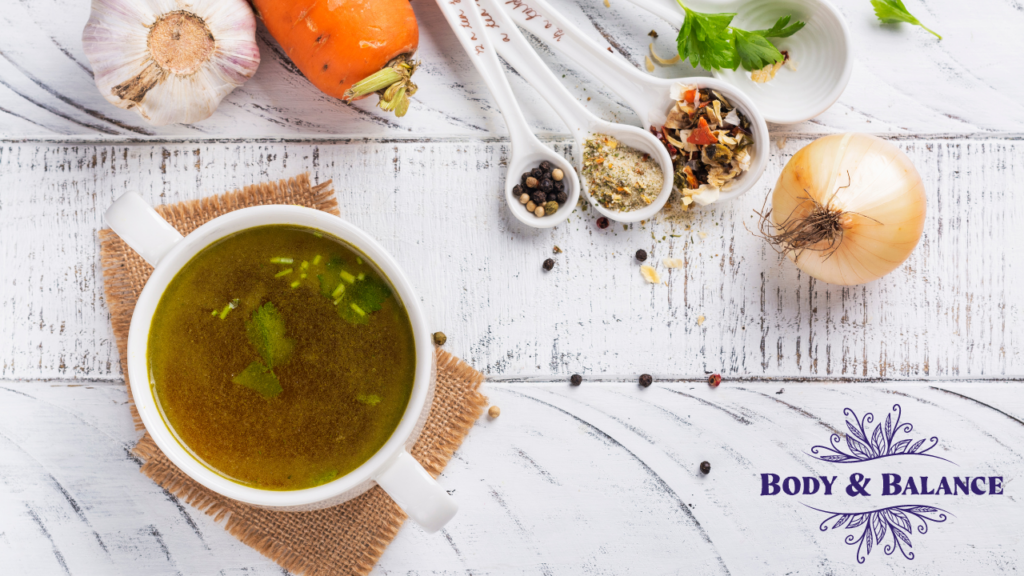It’s early evening and the house has filled up with noise as your family is all coming home. It’s cold outside and everyone has a bit of a chill. For years the go-to remedy has been a nice warm broth. What if that same broth could have a ton of health benefits, as well? It can. Read on to learn about the benefits of bone broth.
What is bone broth?
Going beyond just “stock” or a beef or chicken broth, bone broth takes it to a whole other level. Bone broth is created by boiling beef, chicken, fish, lamb or other bones for a minimum of 12 hrs. Bone broth has many compounds and minerals that are known to be healthy.
When boiled then simmered for long amounts of time, the bones are known to release healthy compounds. These compounds are collagen, proline, glycine, and glutamine. In addition, bone broth contains minerals. These minerals include: calcium, magnesium phosphorus, silicon, sulphur and more in a form that your body can easily absorb.
Healing Benefits for Your Gut
It’s frequently being pointed out that the majority of healthy problems begin in the gut. An unbalanced mix of microorganisms in the digestive system are the unhealthy result of a poor diet. This poor diet is going to be less than ideal. It includes too high in sugars and too low in healthful fats, beneficial bacteria and a strong protein base.
When made correctly, bone broth has a ton of healing properties and health benefits. The first big benefit is going to be found in improved gut health. The gelatin found in bone broth is a hydrophilic colloid. This colloid attracts and holds liquids, including digestive juices, which will support proper digestions. This may help heal and seal the gut, promoting healthy digestion.
A study published in 2000 revealed that chicken soup did indeed have medicinal qualities and could help fight infection. For starters, chicken contains a natural amino acid called cysteine. Cysteine can thin mucus in the lungs. It also make it less sticky so that it can be expelled more easily with a productive cough. This is homemade chicken soup, of course; store bought soup will not be as rich in nutrients. Having said that, a chicken bone broth would be even more beneficial.
Healing Benefits for Your Body
Bone broth is also rich in other amino acids such as glycine, proline and arginine which all have anti-inflammatory effects. Glycine also has a calming effect, which may promote sleep, and arginine has been found to be particularly beneficial in the treatment of sepsis. Boiled down bone and cartilage will be rich in chondroitin sulphates, glucosamine and other compounds that can reduce joint pain and inflammation.
As previously stated, bone broth is rich in calcium, magnesium, and other nutrients that play a vital role in strong, healthy bones.
Finally, the gelatin found in all bone broths promotes healthy hair and nail growth.
Now this is certainly not an exhaustive list as many additional benefits of bone broth continue to be discovered. Some sources say that bone broth can actually help overcome food intolerances and allergies as well as boost the immune system and even reduce cellulite.
Preparing for Bone Broth
Clearly the first step is collecting the bones, depending upon which kind of broth you are choosing to make. The easiest is going to be collecting bones from your own meals: from roasts or steaks and roasted chickens or turkeys. These can be sealed in freezer bags and frozen for up to 3 months.
Many times you’ll be able to get the best bones from a local butcher. Call ahead to the butcher at a local grocer and ask them to set aside soup bones such as marrow, knuckle or neck. No matter the source, make sure that the bones have a lot of ligament and marrow. With poultry, you really can’t go wrong with choosing neck, breastbones or wings.
Prepare Your Bones
It is probably a good idea to roast the bones prior to preparing your broth. Doing so adds color and flavor to your finished broth. If there are any crusty bits stuck to the side of the pan, be sure to add some water and scrape the up with a wooden spoon. Add them to the broth to simmer in the flavor.
Next you’ll want to place the roasted bones in a large stockpot, slow cooker or pressure cooker. (The pros and cons of these options will be presented.) Simmer as directed to leach flavor and minerals from the bones. Cool the broth slightly and strain through a sieve or a colander lined with cheesecloth; this will collect all the small particles. Should you wish to remove the fat first, be sure to cool the broth because the flat will float to the surface and then firm making it easy to scrape off and discard.
Options for Making Bone Broth
Many will choose to use a standard stock pot and stove top preparations. When choosing this anner, remember that there will be more evaporation. While this may boost the flavor it also requires watching more closely and means that there will be less bone broth produced. On the stove this process takes 12 hours so watching it closely will be time consuming.
Another option is a slow cooker, which will not have to be closely watched but typically doesn’t have as much volume as a stock pot and so the recipe will need to be cut in half.
Finally, a pressure cooker is probably the best option. It doesn’t have to be watched, takes only 2 hours, and results in the same rich flavor. However, similar to the slow cooker or crock pot, there is limited space and the recipe will need to be reduced by half.
How to Make Bone Broth
Most base recipes will include vegetables and seasonings but all recipes will include apple cider vinegar. This is the most important ingredient because the vinegar draws the important compounds and nutrients out of the bones.
A simple search of the internet will result in several recipe options. Most include celery, carrots, onions and seasonings. Depending upon which recipe you choose, some things will remain the same.
Cook Your Broth
If choosing to cook stove-top in a stock pot, remember to go with a gentle simmer. If you cook it too fast or boil it too hard then it will not have all the health benefits available.
Should you decide to use a slow cooker, remember to cover it and cook on low power for 10 to 12 hours. The importance of slow cooking is giving the water and vinegar mix time to draw out as much nutrition as possible from the bones.
Finally if a pressure cooker is available, then this will be the fastest cooking option. With an electric cooker, you will want to lock the lid in place and set the cooker on high pressure for 1 1/2 hours. If using a stove-top cooker, bring up the pressure to medium-high heat according ot the manufacturer’s directions then reduce the heat enought to maintain a steady (but not excessive) pressure and cook for 1 1/2 hours. With both models be sure to let stand until the pressure releases naturally (typically about 15 minutes). If needed, open the steam valve to release any remaining pressure.
When done your options include serving some immediately or letting cool to remove excess fat prior to storage. To store, place in an airtight container. Cover and chill up to 3 days or freeze for up to 6 months.
The Chiropractic Factor
Your Doctor of Chiropractic is dedicated to helping your family stay healthy. Giving you natural, homeopathic options, such as bone broth, to boost your immune system and support your health is a major part of this commitment.
To learn more about the benefits of chiropractic care. Click to schedule a complimentary consultation with Body & Balance’s practitioners today.
RESOURCES: DR. CLAUDIA ANRIG-THE WELLNESS FAMILY



